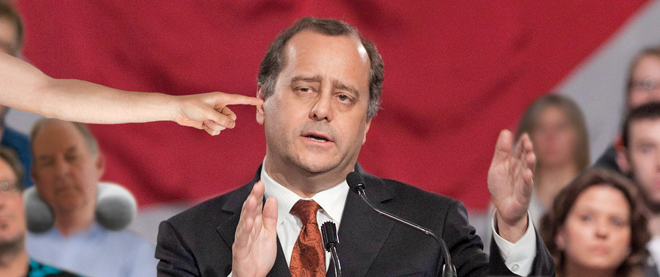The NDP’s human shields of tedium
Scott Feschuk on how watching the poor suckers in the background was the fun part of the leaders’ debate
CP; Getty Images; Photo Illustration by Taylor Shute
Share

The first debate of New Democratic Party leadership hopefuls, televised live on CPAC, answered a number of important questions: Ottawa? Broken. Conservatives? Out of touch. Production values? Can’t afford them.
The Republican presidential debates in the U.S. have featured expensive-looking video backdrops. The NDP opted for something much cheaper: humans. They shoehorned women and men behind the nine contenders to succeed Jack Layton. Presumably, party officials wanted to convey the multicultural appeal of the party—and they would have succeeded, too, had audience members not looked as though they were contestants on a reality show entitled Remain Grim-Faced or This Puppy Gets Stabbed.
Still, these human shields of tedium were easily the most fascinating element of an otherwise platitudinous affair. For instance, there was a moment when front-runner Brian Topp caught fire with a passionate call to action—but then one of the guys behind him started picking at his ear. (At his own ear, to be clear—not at Topp’s ear. Still: distracting.)
To Canadians at large, several of the candidates for the NDP leadership are virtual unknowns. The rest aspire to be virtual unknowns. Martin Singh, a complete unknown, is apparently a pharmacist out east. He vowed that a Singh government would bring in a pharmacare program that would “not destabilize the pharmacy industry.” This curious priority surely won him the backing of Martin Singh, pharmacist.
(Those keen to dismiss Singh’s chances right there surely thought again when he went on to display a formidable grasp of empty rhetoric, declaring among other things that: “The next prime minister of Canada is going to have to have a solid plan.” As any student of politics knows, empty rhetoric is these days the most important of all the rhetorics.)
With nine contenders on the stage, the debate was broken up into a series of conversations among three of the contenders. Everyone was very polite: “The point you made is a good one . . . you’re right . . . your plan is a very good plan . . . I must agree with you in your points . . . very well spoken . . . I am in violent agreement with my colleagues.” Geez, ease up on one another already.
During the debate, the various candidates vowed that an NDP government would invest in: child care, affordable housing, small businesses, the environment, fighting climate change, reducing poverty, greening the energy grid, expanding wind power, making post-secondary education more affordable, supporting farmers and rural residents and poor children and First Nations and mining towns and forestry towns and, well, just imagine every single thing and everyone in Canada except for seniors and assume they would invest in that. Later, they said they’d also invest in seniors.
“Everybody has to benefit,” said Romeo Saganash, a candidate from Quebec. He was talking about the plight of native people on reserves, but it might as well be the party’s slogan. The debate was supposedly about the economy, but no one even mentioned the deficit or made any significant comment on the financial crisis in Europe. The more the NDP candidates avoided the economic reality of the day (hard choices) and instead debated their fantasy economy that doesn’t exist and never will (a unicorn in every garage), the more the viewer’s eye wandered back to the unfortunate people propped behind the candidates. Results proved enjoyable.
As Paul Dewar discussed investing in job training (he’s in favour of it, so add it to the list), an older woman behind him chatted it up with a gentleman to her left—then bent down and abruptly brought to her face the World’s Largest Hanky. I am not exaggerating the size of the hanky: the thing could have doubled as a dishtowel or even a picnic blanket. The woman pressed it against her nose. She may have blown into it—there was no instant replay, so I couldn’t be sure. Finally, the woman opened up the thing and rubbed it over her whole face for some reason. Dewar went on talking about something or other and no one heard a word because everyone was yelling at their televisions: “Lady, place that infield tarp back in your handbag already!”
Elsewhere, audience members bulged out their eyes to stay awake. A bald man succumbed and drifted off, followed by a blond woman. And it was hard not to think: you want to be compassionate, NDP contenders? Turn around and tell these poor people they can go home.